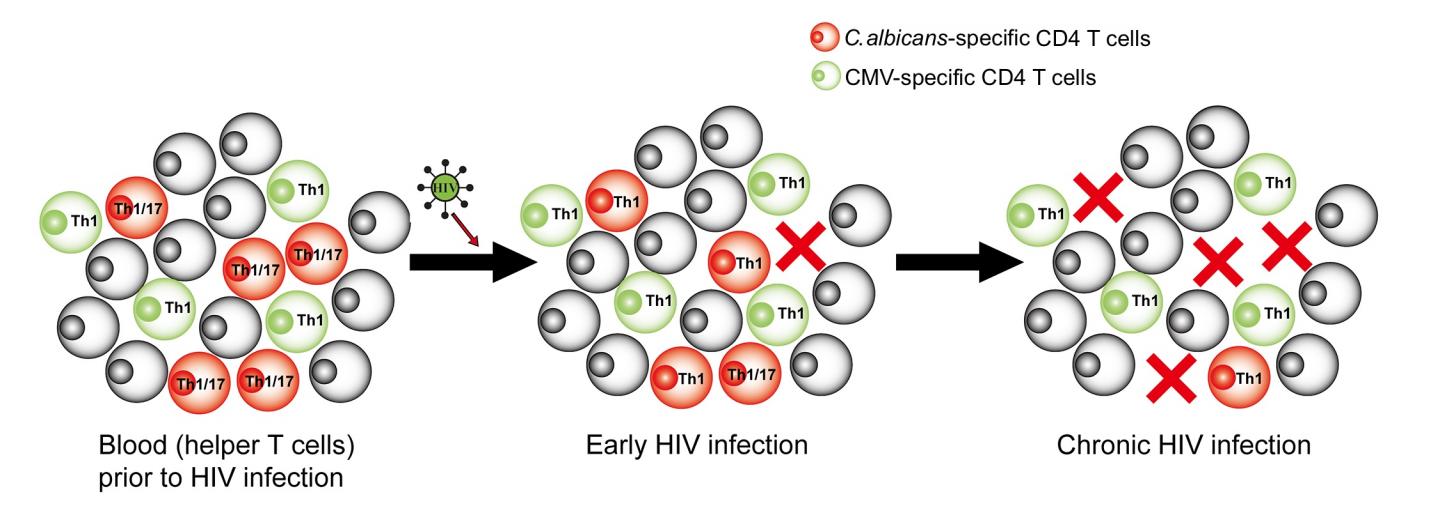
Candida yeasts normally live on human skin and mucous membranes without causing disease. In individuals with a weakened immune system, however, they are a major cause of opportunistic infections. A study published on June 9th in PLOS Pathogens shows how HIV soon after infection specifically targets and destroys the very immune cells that keep Candida in check.
Opportunistic infections–clinically relevant diseases caused by usually harmless microbes–are a hallmark of HIV/AIDS and thought to be caused by a progressively weakening immune system that loses the ability to suppress even known pathogens. It is known that CD4 helper T cells, the primary target of HIV, are a key part of the immune response to many opportunistic microbes. However, HIV-positive individuals do not suddenly become susceptible to all sorts of infections. Instead, there is a consistent sequence in the vulnerability to different opportunistic pathogens during the progression of HIV-infected individuals to AIDS.
Haitao Hu, from the University of Texas Medical Branch in Galveston, USA, and colleagues, are interested in the reasons for this differential vulnerability, including the question why the common opportunistic infections with Candida albicans occur early during HIV/AIDS progression. The researchers had previously discovered that human C. albicans-specific CD4 helper T cells are more permissive to HIV infection in vitro compared to CD4 helper T cells specific for cytomegalovirus (CMV), another opportunistic pathogen but one that usually causes disease at late stages of HIV/AIDS.
In this study, they examine how HIV targets these two groups of pathogen-specific CD4 T-cells in HIV-infected individuals over time. The researchers used consecutive blood samples from 20 HIV-infected individuals who had C. albicans-specific and CMV-specific CD4 helper T cells, experienced progressive loss of overall numbers of CD4 helper T cells over time, and who had not yet started antiretroviral treatment (ART). Compared to CMV-specific cells, the researchers found, C. albicans-specific CD4 T cells were more susceptible to HIV in vivo and preferentially depleted earlier in the HIV-infected individuals.
It is known that C. albicans-specific CD4 T helper cells come in two different 'flavors'. Some of them produce mainly two immune stimulators called IL-17 and IL-22 (and are referred to as Th17 cells), whereas others, so-called Th1 cells, produce predominantly interferons, another type of immune signaling molecule. In the HIV-infected individuals, the researchers saw a sequential dysfunction for C. albicans-specific CD4 T cell response, with an earlier and more profound depletion of Th17 cells. This suggests that these Th17 cells are the ones that primarily prevent C. albicans from causing disease in healthy individuals.
"Based on an ART naïve HIV infection cohort", the authors summarize, "we comparatively investigated the dynamic impact of HIV on C. albicans– and CMV specific CD4 T-cell immunity in HIV non-controllers. We identified a sequential dysfunction and preferential depletion of C. albicans-specific CD4 T cell response during progressive HIV infection". Their results, they suggest, "may provide an immunological basis for early loss of immune control over mucosal candidiasis in HIV-infected individuals and also suggest a potential mechanism for pathogen-specific immune failure in AIDS".
###
In your coverage please use this URL to provide access to the freely available article in PLOS Pathogens: http://dx.plos.org/10.1371/journal.ppat.1005663
Please contact [email protected] if you would like more information.
Funding: The work was supported by National Institutes of Health Grant 1R21AI110214 (to HH) (https://www.niaid.nih.gov/Pages/default.aspx) and the Robert Mapplethorpe Foundation grant (to HH) (http://www.mapplethorpe.org/foundation). The funders had no role in study design, data collection and analysis, decision to publish, or preparation of the manuscript.
Competing Interests: The authors have declared that no competing interests exist.
Citation: Liu F, Fan X, Auclair S, Ferguson M, Sun J, Soong L, et al. (2016) Sequential Dysfunction and Progressive Depletion of Candida albicans-Specific CD4 T Cell Response in HIV-1 Infection. PLoS Pathog 12(6): e1005663. doi:10.1371/journal.ppat.1005663
Media Contact
Haitao Hu
[email protected]
The post Candida-specific helper T cells are preferential and early targets of HIV appeared first on Scienmag.





